Landscape Change Assessment using Unsupervised Image Classification in GRASS GIS
Contents
- 1 Purpose
- 2 Introduction to GRASS GIS
- 3 Methods
- 3.1 Software Download and Installation
- 3.2 Data Set
- 3.3 Starting GRASS GIS
- 3.4 Adding Extensions
- 3.5 Importing Landsat Rasters
- 3.6 Raster Smoothing and Discontinuity Maps
- 3.7 Map Swipe
- 3.8 Segmentation
- 3.9 Pre-Processing
- 3.10 Unsupervised Classification
- 3.11 Landscape Change Assessment
- 3.12 Not Covered in this Tutorial
- 3.13 Additional Resources
- 4 Conclusion
- 5 References
Purpose
The purpose of this tutorial is:
Introduction to GRASS GIS
Methods
Software Download and Installation
In this tutorial, GRASS GIS version 7.8.1 for Windows is being used, however this software is also available for Mac and Linux users. The latest version of GRASS GIS may be downloaded here. This website contains very useful information and documentation for users that have never been exposed to GRASS GIS before now. I highly suggest looking at this documentation, as well as this tutorial which provides more information on GRASS GIS.
Data Set
Because this tutorial is being written to demonstrate the ability of GRASS GIS to assess changes in landscapes, a data set has been provided for the user. There are many sources where one can find satellite imagery data, however a data set is being provided to the user so they may follow along with this tutorial without having their own data set. This data set consists of two GeoTiff files acquired using the Earth Observing System (EOS) Landviewer tool. These GeoTiff files contains an image obtained by Landsat 7 on September 7, 2000 and an image obtained by Landsat 8 on September 23, 2017. Both images contain imagery of the same area of interest (AOI) which consists of a 40.04 km² square area centered at 45.03001°N 75.68135°W. This area is located in Kemptville, Ontario, an area which has undergone development since the early 2000s to accommodate for increased population sizes. The population of Kemptville is expected to rise given it's close proximity to Ottawa, making it an ideal location for commuters to reside, which means that further development is also expected.
| Landscape Change Assessment Data Set | |
|---|---|
| Data Information | Data File |
| GeoTiff file for raster imagery from September 7, 2000 (Landsat 7) | September 2000 File |
| GeoTiff file for raster imagery from September 23, 2017 (Landsat 8) | September 2017 File |
Starting GRASS GIS
Once GRASS GIS is properly installed on your computer, you may locate it and open the program.
Figure 1: Screenshot of GRASS GIS Startup Interface
- 1)
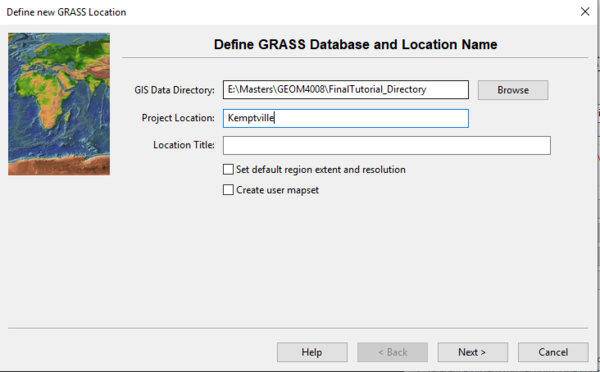 Figure : The Define New Grass Location window where the user selects a data directory and project location.
Figure : The Define New Grass Location window where the user selects a data directory and project location.
- 1)
 Figure : The Define New Grass Location window where the user chooses a method for creating a new location.
Figure : The Define New Grass Location window where the user chooses a method for creating a new location.
- 1)
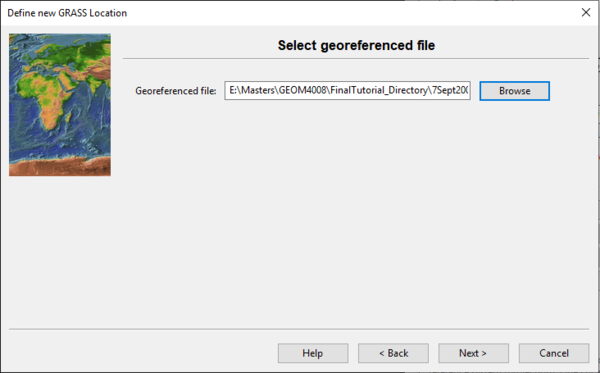 Figure : The Define New Grass Location window where the user selects a georeferenced file.
Figure : The Define New Grass Location window where the user selects a georeferenced file.
- 1)
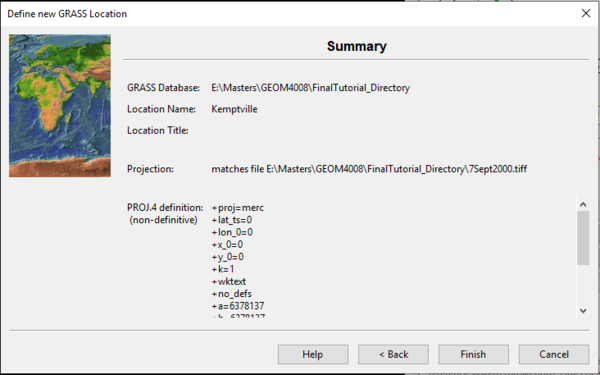 Figure : The Define New Grass Location window summary page.
Figure : The Define New Grass Location window summary page.
Adding Extensions
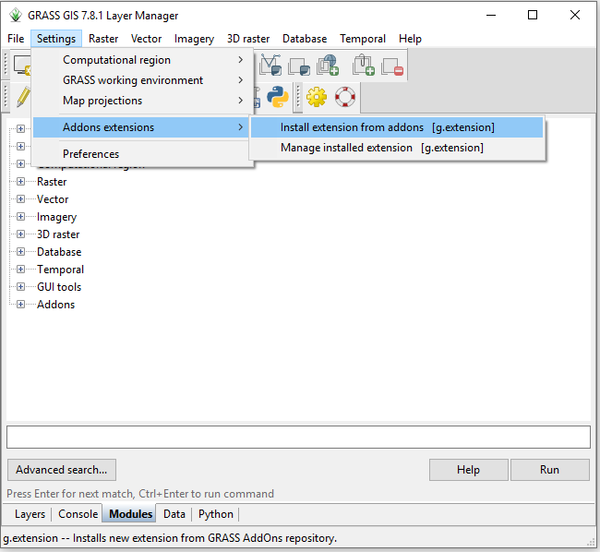 Figure : The path to install new add-ons in GRASS GIS.
Figure : The path to install new add-ons in GRASS GIS.
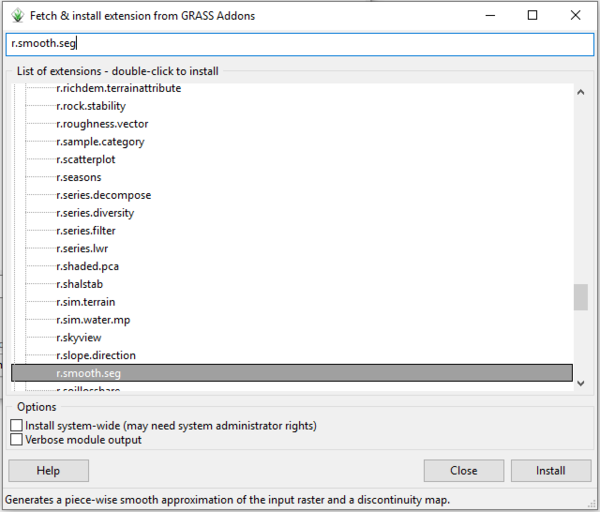 Figure : The "Fetch & Install Extension from GRASS Add-ons" window with search results for the r.smooth.seg add-on.
Figure : The "Fetch & Install Extension from GRASS Add-ons" window with search results for the r.smooth.seg add-on.
- 1) At this point, GRASS GIS must be closed and restarted. Upon opening GRASS GIS for the second time, navigate to the Modules tab at the bottom of the Layer Manager window.
- 2) Click the + sign beside the Addons category to expand it.
- 3) Double-click on the r.smooth.seg add-on to run the selected module.
 Figure : The Layer Manager window with the Modules tab open, and the newly installed add-on selected.
Figure : The Layer Manager window with the Modules tab open, and the newly installed add-on selected.
Importing Landsat Rasters
r.in.gdal [(https://grass.osgeo.org/grass78/manuals/r.in.gdal.html]
- 1)
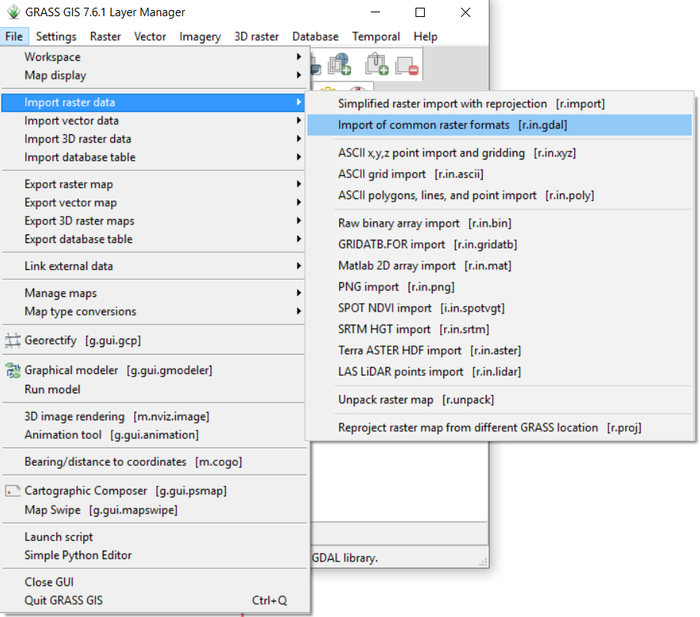 Figure : The path to import raster data using the r.in.gdal module.
Figure : The path to import raster data using the r.in.gdal module.
- 1)
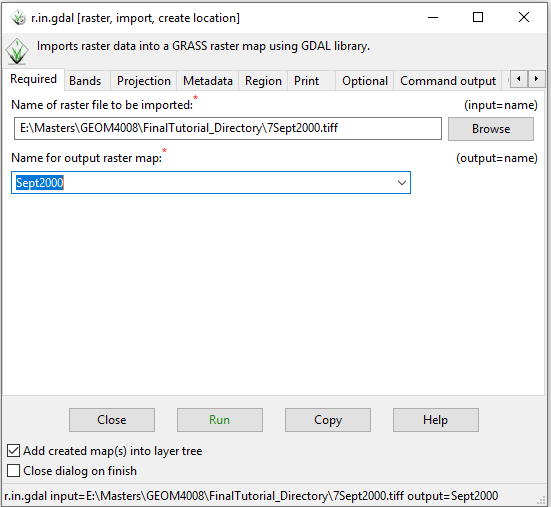 Figure : The r.in.gdal module window showing input and output raster information.
Figure : The r.in.gdal module window showing input and output raster information.
d.rgb [1]
- 1)
600px Figure : The path to add an RGB map layer using the d.rgb module.
600px Figure : The d.rbg module window showing the required input raster information.
800px Figure : The RGB map layer output in the Map Display window.
Raster Smoothing and Discontinuity Maps
r.smooth.seg - image pre-processing (takes place before segmentation)
Map Swipe
Segmentation
i.segment
Pre-Processing
i.cluster
Unsupervised Classification
i.maxlik
Landscape Change Assessment
Not Covered in this Tutorial
Additional Resources
Conclusion
References
https://renx.ca/kemptville-building-boom-retail-residential/
Earth Observing System (EOS) Landviewer [2]
GRASS GIS Software [3]
